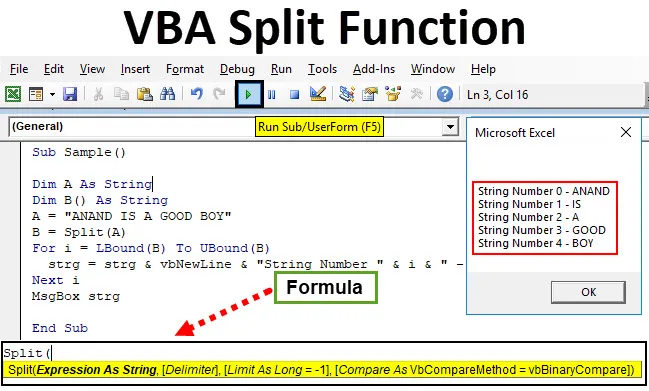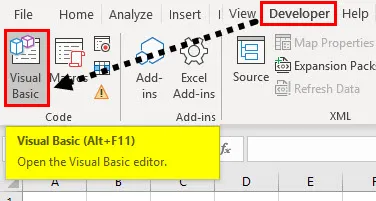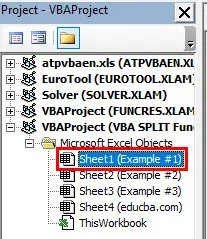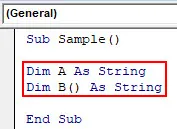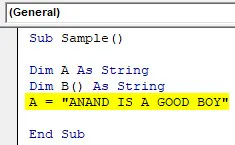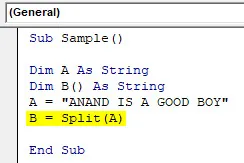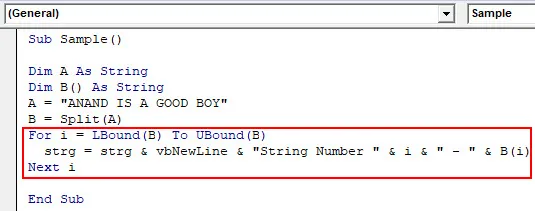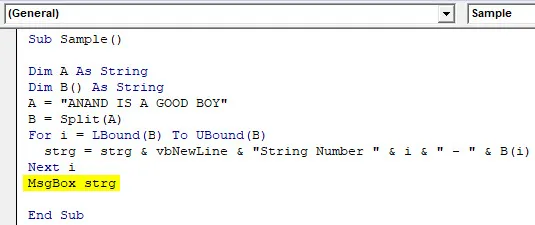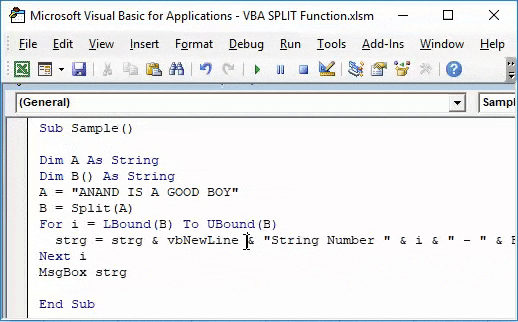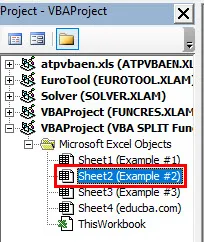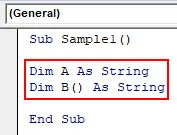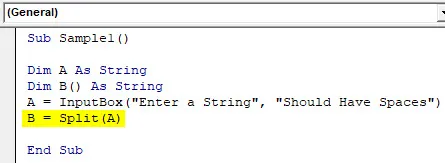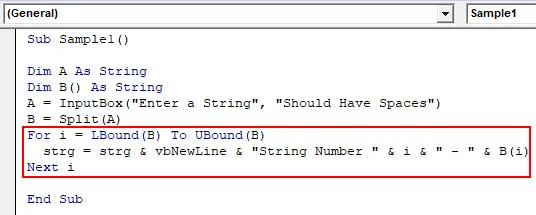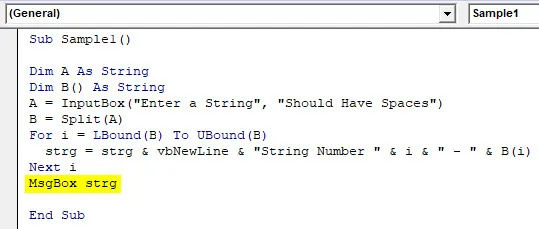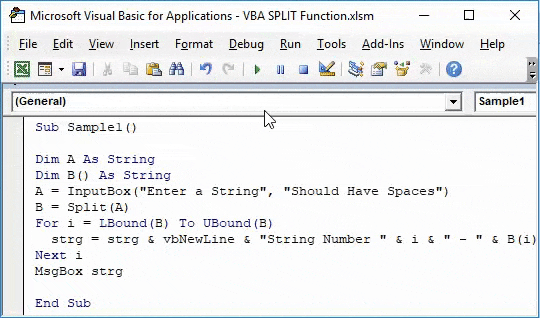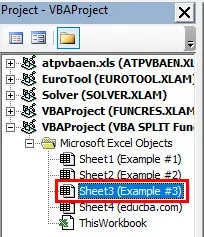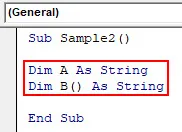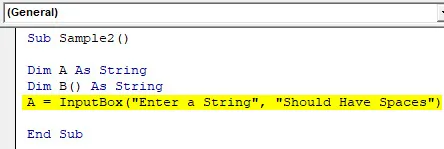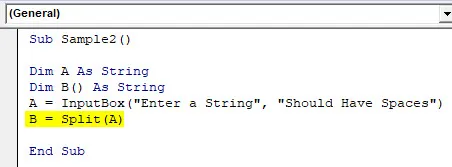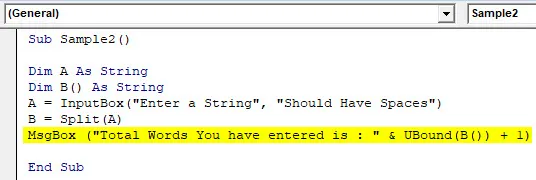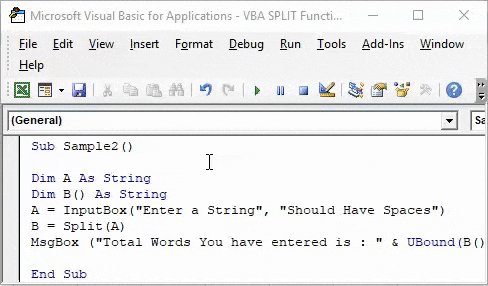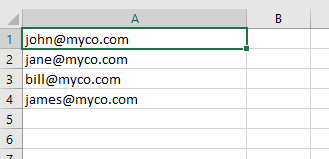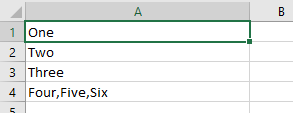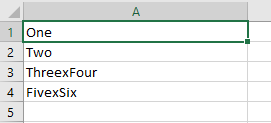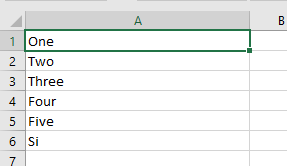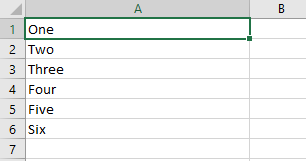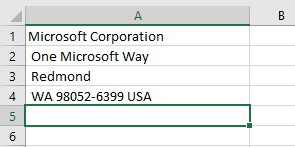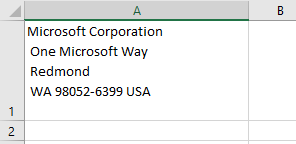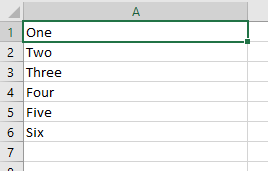Introduction
The VBA Split Function is used is to split a string of text into an array. The text is split based on a given delimiter – e.g. a comma, space, colon etc.
For example, imagine we have the following string:
“Apple:Orange:Pear:Plum”
You can see that each item separated by the colon sign. We call the colon sign the delimiter.
We can split this string into an array:
' https://excelmacromastery.com/ Sub SplitBasic() Dim arr() As String arr = Split("John:Jane:Paul:Sophie", ":") End Sub
Once it is in an array it is easy to access each item:
Glossary
Array – a structure for storing a group of similar variables.
Ubound – this function gives the last position of an array.
Lbound – this function gives the first position of an array. For an array, returned by the Split function, the first position is zero.
Instr – this function is used to search for a string within a string and return the position.
InStrRev – the same as Instr but searches a string from the end.
Split Syntax
Split expression, delimiter[optional], limit[optional], compare[optional]
Split Return Value
The Split function returns an array.
Split Function Parameters
expression – this is the text string that is to be split.
delimiter [optional] – the character delimiter used in the string to separate each item. If you don’t use this parameter then VBA uses space as the delimiter.
limit [optional] – this allows us to set the number of items in the result. If we use 1 as the limit then no split takes place and the full string is returned.
compare [optional] – if we are using letters as the delimiter then this determines if we take the case of letters into consideration.
VBA Split – Simple Example
The following code shows an example of using the Split function and printing the result to the Immediate Window:
' https://excelmacromastery.com/ Sub VBA_Split_Print() Dim arr() As String ' Split the string to an array arr = Split("John:Jane:Paul:Sophie", ":") ' Print each item in the array to the Immediate Window(Ctrl + G) Dim name As Variant For Each name In arr Debug.Print name Next End Sub
Output
John
Jane
Paul
Sophie
When we split the string into an array we have an item in each position in the array. This means we can easily access any item using the array position:
' https://excelmacromastery.com/ Sub VBA_Split_PrintArr() Dim arr() As String ' Split the string to an array arr = Split("John:Jane:Paul:Sophie", ":") Debug.Print arr(0) ' Print John Debug.Print arr(1) ' Print Jane Debug.Print arr(2) ' Print Paul Debug.Print arr(3) ' Print Sophie End Sub
Split returns an array that starts at position zero. If we want to use a For statement to read through the array we can use LBound and UBound to give us the first and last positions of the array:
' https://excelmacromastery.com/ Sub VBA_Split_Print() Dim arr() As String ' Split the string to an array arr = Split("John:Jane:Paul:Sophie", ":") ' Print each item in the array to the Immediate Window(Ctrl + G) Dim i As Long For i = LBound(arr) To UBound(arr) Debug.Print arr(i) Next End Sub
Split Limit Parameter
The Limit parameter is used to determine how items are placed in the array. In other words, how many items is the original string split into.
The table below shows the results of using different limits this sample string:
| String | Limit | Result |
|---|---|---|
| «John:Jane:Paul:Sophie» | 1 | John:Jane:Paul:Sophie |
| «John:Jane:Paul:Sophie» | 2 | John Jane:Paul:Sophie |
| «John:Jane:Paul:Sophie» | 3 | John Jane Paul:Sophie |
| «John:Jane:Paul:Sophie» | 4 | John Jane Paul Sophie |
You can try out the code for yourself:
' https://excelmacromastery.com/ Sub VBA_Split_Limit() Dim arr() As String ' Split the string to an array arr = Split("John:Jane:Paul:Sophie", ":", 1) ' Print each item in the array to the Immediate Window(Ctrl + G) Dim name As Variant For Each name In arr Debug.Print name Next End Sub
Split Compare Parameter
The Compare parameter is used for delimiters that are made up of one or letters.
For example, imagine we want to use the letter x as a delimiter in the following string:
“12x34X45x”
- If we want to split by x when lower case only – then we use vbBinaryCompare.
- If we want to split by upper or lower case x – then we use vbTextCompare.
- vbUseCompareOption is the default and tells split to use the module Compare settings. Read more about the module compare settings here.
The following code shows how we use the Compare parameter:
' https://excelmacromastery.com/ Sub VBA_Split_Compare() Dim arr() As String ' Split the string to an array - not case sensitive arr = Split("12x34X45", "x", , vbTextCompare) ' Print each item in the array to the Immediate Window(Ctrl + G) Dim name As Variant For Each name In arr Debug.Print name Next End Sub
The following table shows the results from the different Compare arguments:
| String | Delimiter | Compare Type | Result |
|---|---|---|---|
| «12x34X45» | x | vbCompareText | 12 34 45 |
| «12x34X45» | x | vbCompareBinary | 12 34X45 |
Reversing Split
We can use the Join function to do the opposite of what the split function does. Join converts an array into a string and adds a given delimiter.
This can be useful as sometimes we may want to split a string, update one or more values in the array and then convert the array to a string.
This example shows how to use Join:
' https://excelmacromastery.com/ Sub UsingJoin() Dim arr As Variant ' create an array using the array function arr = Array("Apple", "Orange", "Pear") Dim s As String ' Covert the array to a string using the colon delimiter s = Join(arr, ":") ' Print the string to the Immediate Window(Ctrl + G) Debug.Print s End Sub
See the section “Split Example – Using Join” for an example of using the Join function with the Split function.
Split Example – Names
A really great example of Split is when dealing with names.
Imagine we have the name “John Henry Smith” and we want to extract each name.
We can use Left and Instr to get the first name:
' https://excelmacromastery.com/ Sub Instr_Firstname() Dim s As String s = "John Henry Smith" ' Get the position of the first space Dim position As Long position = InStr(s, " ") - 1 ' Prints John Debug.Print Left(s, position) End Sub
To get the last name is a bit trickier:
' https://excelmacromastery.com/ Sub Instr_Lastname() Dim s As String s = "John Henry Smith" ' Get the position of the last space Dim position As Long, length As Long position = InStrRev(s, " ") - 1 length = Len(s) ' Prints Smith Debug.Print Right(s, length - position) End Sub
Getting names that are not in the first or last position gets very messy indeed. However, using Split we can simplify the whole process:
' https://excelmacromastery.com/ Sub SplitName() Dim s As String: s = "John Henry Smith" Dim arr() As String arr = Split(s, " ") Debug.Print arr(0) ' John Debug.Print arr(1) ' Henry Debug.Print arr(2) ' Smith End Sub
We actually don’t need to use an array as we can see in the next example. It is not efficient to call the Split function 3 times instead of 1 but it does look nice in this example:
' https://excelmacromastery.com/ Sub SplitName() Dim s As String: s = "John Henry Smith" Debug.Print Split(s, " ")(0) ' John Debug.Print Split(s, " ")(1) ' Henry Debug.Print Split(s, " ")(2) ' Smith End Sub
Split Example – Filenames
In the next example we use Split to get the extension part of a filename:
' https://excelmacromastery.com/ Sub GetFileExt() ' Create an array of filenames for our test Dim myFiles As Variant myFiles = Array("my resume.xlsx", "myresume2.doc", "my resume latest ver.pdf") Dim file As Variant, arr() As String ' Read through the filenames For Each file In myFiles ' Split by the period arr = Split(file, ".") ' Use Ubound to get the last position in the array Debug.Print arr(UBound(arr)) Next file End Sub
Here is an interesting one you can try for yourself. Given a full file name, try to write code to extract the filename without the extension or folder.
For example for “C:MyDocsJanMyResume.Doc” we want to extract MyResume.
' https://excelmacromastery.com/ Sub GetFilenamePart() ' Create an array of filenames for our test Dim myFiles As Variant myFiles = Array("C:MyDocsJanMyResume.Doc" _ , "C:MyMusicSongslovesong.mp3" _ , "D:MyGamesGamesSavedsavedbattle.sav") Dim file As Variant, arr() As String ' Read through the filenames For Each file In myFiles ' Split by the period arr = Split(file, ".") ' Split by the folder separator / arr = Split(arr(0), Application.PathSeparator) Debug.Print arr(UBound(arr)) Next file End Sub
Output
MyResume
lovesong
savedbattle
Split Example – Copy to a Range
Because the result of Split is an array, we easily copy it to a range.
' https://excelmacromastery.com/ Sub VBA_Split_Range() Dim s As String s = "001,John Smith,New York,067435334" ' write the values to cells A1 to D1 Sheet1.Range("A1:D1").Value = Split(s, ",") ' write the values to cells A1 to A4 Sheet1.Range("A1:A4").Value = WorksheetFunction.Transpose(Split(s, ",")) End Sub
Split Example – Count Items
If we want to count the number of items in a delimited string we can use Split to do this for us.
We simply split the string and then use the Ubound function to give us back the number of items. We saw already that UBound is used to give us back the last position in an array. Because, the array start at zero, we need to add one to get the number of items.
' https://excelmacromastery.com/ Sub Split_Count() Dim s As String s = "Apple,Orange,Mango,Peach,Plum,Banana,Pear" Debug.Print "number of items:" & UBound(Split(s, ",")) + 1 End Sub
Split Example – Using Join
This is an interesting one that you may want to try yourself. Take the three strings below:
123.3456.96.345
1234.1156.7.345
1273.9998.123.345
We want to add one to the third number in each string. For example, the first string should become 123.3456.97.345.
Before you try yourself, I will give one hint. You can use the Join function to reverse the Split operation. It takes a array and delimiter and creates a string.
You can start with this code:
' https://excelmacromastery.com/ Sub UpdateNumber() ' Create an array of number for our test Dim myNums As Variant myNums = Array("123.3456.99.345" _ , "1234.1156.7.98" _ , "1273.9998.123.3235") ' Read through the strings Dim i As Long, arr() As String For i = LBound(myNums) To UBound(myNums) ' add your code here Next i ' Print the updated array to the Immediate Window(Ctrl+G) Debug.Print vbNewLine & "Printing new array" For i = LBound(myNums) To UBound(myNums) Debug.Print myNums(i) Next i End Sub
This is how to do it:
' https://excelmacromastery.com/ Sub UpdateNumber() ' Create an array for our test Dim myNums As Variant myNums = Array("123.3456.99.345" _ , "1234.1156.7.98" _ , "1273.9998.123.3235") ' Read through the strings Dim i As Long, arr() As String For i = LBound(myNums) To UBound(myNums) ' Split the string to an array arr = Split(myNums(i), ".") ' Add one to the number arr(2) = arr(2) + 1 ' convert the array back to a string myNums(i) = Join(arr, ".") Next i ' Print the updated array to the Immediate Window(Ctrl+G) Debug.Print vbNewLine & "Printing new array" For i = LBound(myNums) To UBound(myNums) Debug.Print myNums(i) Next i End Sub
Output
123.3456.100.345
1234.1156.8.345
1273.9998.124.345
Further Reading
The Ultimate Guide to VBA String Functions
Extracting using the Split function
VBA Arrays
VBA For Loop
Microsoft Docs – Split function
If you would like to see some real-world examples of using Split, you will find them in the post How to Easily Extract From Any String Without Using VBA InStr.
What’s Next?
Free VBA Tutorial If you are new to VBA or you want to sharpen your existing VBA skills then why not try out the The Ultimate VBA Tutorial.
Related Training: Get full access to the Excel VBA training webinars and all the tutorials.
(NOTE: Planning to build or manage a VBA Application? Learn how to build 10 Excel VBA applications from scratch.)
Использование функции Split в VBA Excel, ее синтаксис и параметры. Значения, возвращаемые функцией Split. Примеры использования.
Функция Split предназначена в VBA Excel для разделения строки на подстроки по специальным меткам — разделителям. Разделителем может быть как отдельный символ, так и строка из нескольких символов. Функция Split по своему действию является обратной функции Join, которая создает одну строку из массива подстрок.
Синтаксис функции
|
Split (Expression,[Delimiter],[Limit],[Compare]) |
Обязательным параметром функции Split является Expression. Если остальные параметры явно не указаны, используются их значения по умолчанию.
Параметры функции
| Параметр | Описание | Значение по умолчанию |
|---|---|---|
| Expression | Строка, содержащая подстроки и разделители | Нет |
| Delimiter | Разделитель, представляющий один или более символов | Пробел |
| Limit | Максимальное число подстрок, на которые должна быть разделена входная строка | -1 |
| Compare* | Определяет, какое используется сравнение, двоичное — CompareMethod.Binary (0) или текстовое — CompareMethod.Text (1) | 0 |
*Если используется двоичное сравнение (0 или CompareMethod.Binary), функция чувствительна к регистру букв. Если используется текстовое сравнение (1 или CompareMethod.Text), функция не чувствительна к регистру букв.
Возвращаемые значения
Функция Split возвращает одномерный массив с индексацией от нуля, который содержит указанное параметром Limit число подстрок. Чаще всего, функция Split используется со значением параметра Limit по-умолчанию, равному -1, когда возвращаются все найденные в исходной строке подстроки.
Пример 1
|
Sub Test1() Dim a() As String a = Split(«vremya ne zhdet») MsgBox a(0) & vbNewLine & a(1) & vbNewLine & a(2) End Sub |
Результат в MsgBox:
vremya
ne
zhdet
В первом примере используются Delimiter и Limit по-умолчанию.
Пример 2
|
Sub Test2() Dim a() As String a = Split(«vremya-ne-zhdet»,«-«, 2) MsgBox a(0) & vbNewLine & a(1) End Sub |
Результат в MsgBox:
vremya
ne-zhdet
Во втором примере Delimiter = «-«, а Limit = 2.
Для присваивания результатов функции Split используется предварительно объявленный текстовый динамический массив, который можно использовать в строке присваивания с пустыми скобками или без них. В представленных выше примерах массив указан без скобок.
Вы можете скопировать коды из приведенных примеров в модуль VBA своей рабочей книги Excel, посмотреть, как они работают. Поэкспериментируйте, подставляя свои данные, чтобы на практике ознакомиться с возможностями функции Split.
|
AlexTM Пользователь Сообщений: 432 Win7SP1 EXL2010 / Win8.1 EXL2016 (VM) |
Доброго дня. Очень интересует, есть ли в VBA встроенная функция, которая бы позволяла проанализировать ячейку на предмет новых строк в ней, то есть когда в одной ячейке записаны сразу три строки (каждая с новой строки), и их надо разделить каждую по своей ячейке? Заранее благодарю. Пример прикреплен, если на словах не совсем понятно.. Прикрепленные файлы
|
|
AlexTM Пользователь Сообщений: 432 Win7SP1 EXL2010 / Win8.1 EXL2016 (VM) |
Да, прошу прощения, в примере в третьей ячейке забыл выделить еще одну строку… что-то не заметил Изменено: AlexTM — 10.07.2015 10:18:41 |
|
vikttur Пользователь Сообщений: 47199 |
|
|
Казанский Пользователь Сообщений: 8839 |
#4 10.07.2015 10:21:21 «Новая строка» это символ перевода строки, в VBA есть константа vbLf. Соответственно, можно получить массив строк с помощью
Изменено: Казанский — 10.07.2015 10:22:00 |
||
|
AlexTM Пользователь Сообщений: 432 Win7SP1 EXL2010 / Win8.1 EXL2016 (VM) |
А не сильно затруднит показать строчкой кода на примере одной ячейки? |
|
AlexTM Пользователь Сообщений: 432 Win7SP1 EXL2010 / Win8.1 EXL2016 (VM) |
#6 10.07.2015 10:31:21 На мой способ проверки что-то ругается vba… Ошибка Can’t assign to array
Изменено: AlexTM — 10.07.2015 10:36:58 |
||
|
vikttur Пользователь Сообщений: 47199 |
Закомментируйте |
|
AlexTM Пользователь Сообщений: 432 Win7SP1 EXL2010 / Win8.1 EXL2016 (VM) |
vikttur, СПАСИБО!!! |
|
V Пользователь Сообщений: 5018 |
#9 10.07.2015 10:41:42 оставьте просто Dim myArr остальное в строчке удалите
|
||
|
AlexTM Пользователь Сообщений: 432 Win7SP1 EXL2010 / Win8.1 EXL2016 (VM) |
V, просто обращение к элементам массива мне удобнее, так копировать в итоге нужно будет, но все равно спасибо за неравнодушие! |
|
AlexTM Пользователь Сообщений: 432 Win7SP1 EXL2010 / Win8.1 EXL2016 (VM) |
#11 10.07.2015 13:58:27 С трудом вымутил вот такой код:
НО он ОЧЕНЬ долго работает. В таблице больше 27-ми тысяч строк, время выполнения будет порядка 8-ми часов. Можно что-то упростить? Есть подозрение, что это из-за постоянной перезаписи массива… Как бы это упростить… Изменено: AlexTM — 10.07.2015 14:00:34 |
||
|
ikki Пользователь Сообщений: 9709 |
#12 10.07.2015 14:10:01 попробуйте…
фрилансер Excel, VBA — контакты в профиле |
||
|
ikki Пользователь Сообщений: 9709 |
у меня 100 строк обработалось за 0,17сек. 0,17/100*27000 = 46 сек. фрилансер Excel, VBA — контакты в профиле |
|
AlexTM Пользователь Сообщений: 432 Win7SP1 EXL2010 / Win8.1 EXL2016 (VM) |
ikki, честно, вообще ничего не понял из Вашего кода, но он работает!!! Мой — это просто какая-то медуза… В любом случае, безмерно благодарен! |
|
ikki Пользователь Сообщений: 9709 |
гм… ну посмотрите… фрилансер Excel, VBA — контакты в профиле |
|
AlexTM Пользователь Сообщений: 432 Win7SP1 EXL2010 / Win8.1 EXL2016 (VM) |
ikki, спасибо-спасибо, буду изучать-учиться! Спасибо! |
|
Andych Пользователь Сообщений: 242 |
#17 10.07.2015 18:38:22 Формулы немного медленнее. |

VBA is prebuilt into Microsoft Excel (and other office suite applications). To access VBA, you need to enable the developer tab first, if you haven’t already. Click on a spot on your ribbon (at the top) and choose the Customize the Ribbon option. By default, the Developer tab is unchecked. Enable it and click on Ok. A new tab should appear next to the View tab on top of your screen. This is the Developer tab, through which you can access VBA and Macros in general. The Developer tab lets you add VBA objects to your spreadsheet (you can check out this course to learn more about using VBA and Macros with Excel).
Like other programming languages, VBA lets you play around with strings and perform various operations on them. The split function is the function that lets you work with lengthy strings in Excel.If you’re new to VBA, or programming languages in general, and don’t know what strings are, we recommend you sign up for our Excel VBA beginner course for an introduction to the language.
The Excel VBA Split function was introduced in the year 2000, in response to a growing need to have a function that could handle large strings (for example, “John Harry David Smith” or “welcome to this tutorial”). The split function is used to split, or break, a string into manageable chunks.
If you’re familiar with Excel spreadsheets (if not, you can take a basic Excel course here), you know that sometimes parts of a long name get hidden – they can’t fit in the confines of a single cell. With the split function, what you can do is split the string into smaller parts and get them to occupy separate cells. For example, if you had a name “John Harry David Smith” and it was occupying cell A1, you can use the split function to separate the name and get it to occupy cells A1, B1, C1 and D1. Sounds useful, doesn’t it? Of course, this is just one of the uses of a split function.
VBA Split Syntax
What the split function does is split a string into an array and then returning that array. This array is one-dimensional. So how do you write a split function? The syntax for the split function is:
Split (string, delimiter, limit, compare)
Here, the string is the text you want to split. The “delimiter” will decide how the text will be split into parts. Usually, the space character “ “ occupies this part of the code. If you don’t define a delimiter, a space character “ “ will be used by default. The limit defines the number of the strings is allowed to divide into. By default, the limit is linked to the delimiter (default value of -1). This means that the delimiter part of the code will decide the number of parts the string gets divided into. The compare method lets you specify the method of comparison: binary (0) or text (1). You don’t have to specify the compare parameter either. By default, it will revert to binary (0).
Example 1
Let’s take a couple of examples to help you understand how the string function works. In the first example, let’s split the string “welcome to this tutorial” and print the words of the string separately (on a new line). The code for that is as follows:
Sub Example() Dim text As String Dim message As Variant Dim a As Long text = "welcome to this tutorial" message = Split(text, " ") For a = 0 To UBound(message) Debug.Printmessage(a) Next a End Sub
Try running this code and see what happens. You will get the message “welcome to this tutorial” printed on 4 different lines.
So how does the code work exactly? First, we initialized text as a string variable, message as a variant variable and a as long variable. A variant variable is a necessity if you are working with the split function. It allows the string text to be treated as split-able. We followed the syntax and used the default delimiter “ “. Finally, we used a for loop to get the array printed on separate lines. 0 defines the starting position of the array and UBound defines the maximum (ending) position of the array.
Example 2
Now let’s write a program to separate a big name (John Harry David Smith) written on a single cell in Excel and get it printed on 4 different cells. Let’s write the name on cell A1 as in the image:
The code for that is as follows:
Sub example() Dim text As String Dim a As Integer Dim name As Variant text = ActiveCell.Value name = Split(text, " ") For a = 0 To UBound(name) Cells(1, a + 1).Value = name(a) Next a End Sub
The code in this example is similar to the code in the previous example. The ActiveCell.Value tells the computer to look for the active cell (A1) and get the string value written there. The split function is used exactly like we have in the previous example. The Cells(1, a + 1).Value part of the code accesses the first row (1) of the spreadsheet. The loop is used to run through the parts of the array and get the string separated and printed into different cells. The final result should look like this, once your run your code:
You can see how useful the split function is. You can also use the split function to omit unnecessary words or symbols (like the “.” character) from your string.
We recommend that you practice with the code we’ve given above to find out how to do that. Try to change the text entered and change the value of the delimiter, limit and compare parts of the split function syntax. Alternatively, you can sign up for our advanced Excel VBA course, where we teach you how to do that, and about using VBA efficiently in general.
- Функция разделения VBA
Функция разделения VBA
Как следует из названия, Split — это функция, которая разбивает строки на разные части. У нас есть много таких функций в таблицах Excel, таких как левый правый и средний. Но когда нам нужна любая строка для разграничения по частям, мы используем функцию Split в VBA. Это одна из лучших функций в VBA для выполнения различных типов операций со строками.
Функция split в основном является функцией подстроки, которая принимает строку в качестве входных данных и дает другую строку в качестве выходных данных. Единственное отличие между другой функцией подстроки, такой как left right, mid и split, заключается в том, что функция LEFT, RIGHT & MID просто принимает одну строку в качестве ввода или аргумента и возвращает одну строку в качестве вывода, в то время как функция SPLIT возвращает массив строк в виде выход.
Формула для функции разделения в Excel VBA
Функция разделения VBA имеет следующий синтаксис:
Позвольте мне сначала объяснить аргументы для функции разделения VBA:
- Выражение в виде строки: это обязательный аргумент в функции разделения VBA. Выражение в виде строки относится к строке, которую мы хотим разбить на части.
- Разделитель: это необязательный аргумент. Это символ, который используется для разбиения строк на части. Но если мы не предоставляем какой-либо разделитель, VBA рассматривает пробел «» как разделитель по умолчанию.
- Ограничение: это также необязательный аргумент. Предел означает максимальное количество частей, которые мы хотим сделать из строки. Но опять же, если мы не предоставляем ограничение для функции, VBA рассматривает его как значение по умолчанию -1, что означает, что строка будет разбиваться на части каждый раз, когда в строке есть разделитель.
- Сравните: этот последний аргумент также является необязательным аргументом. Сравнение — это метод, который описан как один из двух ниже:
- Либо это 0, что означает, что Split выполнит двоичное сравнение, что означает, что каждый символ должен соответствовать самому себе.
- Или это может быть 1, что означает, что функция Split сделает текстовое сравнение.
Все будет понятно на нескольких примерах. Но позвольте мне сначала привести очень простой пример того, что делает эта функция. Предположим, у нас есть входная строка как ANAND — ХОРОШИЙ МАЛЬЧИК. Разделенная строка разбивает его по частям каждое слово отдельно. Мы также можем использовать функцию Split для подсчета количества слов в строке или мы можем использовать ее для вывода только определенного количества слов в данной строке.
Как использовать функцию разделения VBA Excel?
Мы научимся использовать функцию VBA Split Excel на нескольких примерах.
Вы можете скачать этот шаблон VBA Split Excel здесь — Шаблон VBA Split Excel
Функция разделения VBA — Пример № 1
Как насчет того, чтобы мы использовали приведенную выше строку ANAND IS GOOD BOY с функцией split.
Примечание. Чтобы использовать функцию разделения в VBA, убедитесь, что параметр разработчика включен на вкладке «Файл» в разделе параметров.
Шаг 1. Перейдите на вкладку « Разработчик » и нажмите « Visual Basic» .
Шаг 2: Появится окно проекта, чтобы щелкнуть Лист 1, чтобы открыть окно кода.
Шаг 3: Когда появится окно кода, объявите подфункцию, чтобы начать писать код.
Код:
Sub Sample () End Sub
Шаг 4: Объявите два массива переменных и один как строки A и B.
Код:
Sub Sample () Dim A As String Dim B () As String End Sub
Шаг 5: Сохраните значение строки в A.
Код:
Sub Sample () Dim A As String Dim B () As String A = "ANAND IS A GOOD BOY" Конец Sub
Шаг 6: В массиве B сохраните значение A, используя функцию разделения, как показано ниже.
Код:
Sub Sample () Dim A As String Dim B () As String A = "И Я ХОРОШИЙ МАЛЬЧИК" B = Split (A) End Sub
Шаг 7: Используйте For Loop, чтобы разбить каждую строку.
Код:
Sub Sample () Dim A As String Dim B () As String A = "ANAND IS A GOOD BOY" B = Split (A) Для i = LBound (B) К UBound (B) strg = strg & vbNewLine & "String Number "& i &" - "& B (i) Далее i End Sub
Шаг 8: Показать его с помощью функции Msgbox.
Код:
Sub Sample () Dim A As String Dim B () As String A = "ANAND IS A GOOD BOY" B = Split (A) Для i = LBound (B) К UBound (B) strg = strg & vbNewLine & "String Number "& i &" - "& B (i) Next i MsgBox strg End Sub
Шаг 9: Запустите код с кнопки запуска, представленной ниже.
Мы получаем это как вывод, как только мы запускаем приведенный выше код.
Функция разделения VBA — Пример № 2
Теперь мы попытаемся принять ввод от пользователя и разбить строку на части.
Шаг 1: Перейдите на вкладку разработчика и щелкните Visual Basic, чтобы открыть редактор VB.
Шаг 2: Нажмите на Лист 2 в окне свойств, чтобы открыть окно кода.
Шаг 3: В окне кода объявите подфункцию, чтобы начать писать код.
Код:
Sub Sample1 () End Sub
Шаг 4: Объявите две переменные, одну как String, а другую как Array String.
Код:
Sub Sample1 () Dim A As String Dim B () As String End Sub
Шаг 5: Возьмите значение у пользователя и сохраните его в A, используя функцию Inputbox.
Код:
Sub Sample1 () Dim A As String Dim B () As String A = InputBox («Введите строку», «Должно иметь пробелы») End Sub
Шаг 6: Сохраните значение A в массиве B, используя функцию разделения.
Код:
Sub Sample1 () Dim A As String Dim B () As String A = InputBox («Введите строку», «Должно иметь пробелы») B = Split (A) End Sub
Шаг 7: Используйте For Loop, чтобы разбить каждую строку.
Код:
Sub Sample1 () Dim A As String Dim B () As String A = InputBox («Введите строку», «Должно иметь пробелы») B = Разделить (A) Для i = LBound (B) К UBound (B) strg = strg & vbNewLine & "String Number" & i & "-" & B (i) Далее i End Sub
Шаг 8: Показать его с помощью функции Msgbox.
Код:
Sub Sample1 () Dim A As String Dim B () As String A = InputBox («Введите строку», «Должно иметь пробелы») B = Разделить (A) Для i = LBound (B) К UBound (B) strg = strg & vbNewLine & "String Number" & i & "-" & B (i) Далее i MsgBox strg End Sub
Шаг 9: Запустите код с кнопки запуска. Как только мы запустим код, мы получим входное сообщение для записи строки. Напишите «Я ХОРОШИЙ МАЛЬЧИК» в качестве ввода в поле ввода и нажмите ОК, чтобы увидеть результат.
Функция разделения VBA — Пример № 3
Мы также можем использовать функцию разделения VBA для подсчета количества слов в строке. Давайте возьмем ввод от пользователя и посчитаем количество слов в нем.
Шаг 1: Перейдите на вкладку разработчика и щелкните Visual Basic, чтобы открыть VB Editor.
Шаг 2: Нажмите на Лист 3 в окне проекта, чтобы открыть окно кода.
Шаг 3: Когда окно кода открыто, объявите подфункцию, чтобы начать писать код.
Код:
Sub Sample2 () End Sub
Шаг 4: Объявите две переменные, одну как строку, а другую как строку массива.
Код:
Sub Sample2 () Dim A As String Dim B () As String End Sub
Шаг 5: Возьмите ввод от пользователя и сохраните в A, используя функцию поля ввода.
Код:
Sub Sample2 () Dim A As String Dim B () As String A = InputBox («Введите строку», «Должно иметь пробелы») End Sub
Шаг 6: Используйте функцию Split и сохраните ее в B.
Код:
Sub Sample2 () Dim A As String Dim B () As String A = InputBox («Введите строку», «Должно иметь пробелы») B = Split (A) End Sub
Шаг 7: Используйте функцию Msgbox для отображения общего количества слов.
Код:
Sub Sample2 () Dim A As String Dim B () As String A = InputBox («Введите строку», «Должно иметь пробелы») B = Split (A) MsgBox («Всего слов, которые вы ввели:» & UBound ( B ()) + 1) End Sub
Шаг 8: Запустите код с помощью кнопки запуска. Как только мы запустим код, он запрашивает ввод для строки. Напишите в поле «ИНДИЯ — МОЯ СТРАНА» и нажмите «ОК», чтобы увидеть результат.
Объяснение функции разделения Excel VBA
Теперь мы знаем, что функция split в VBA — это функция подстроки, которая используется для разделения строк на разные части. Входные данные, которые мы берем, являются строкой, в то время как отображаемый вывод является массивом.
Она очень похожа на другую функцию рабочего листа, но она лучше, так как может разбивать несколько слов и возвращать их в виде массива.
То, что нужно запомнить
Есть несколько вещей, которые мы должны помнить о функции разделения VBA:
- Функция разделения VBA является функцией подстроки.
- Возвращает вывод в виде строки.
- Только выражение является обязательным аргументом, в то время как остальные аргументы являются необязательными.
Рекомендуемые статьи
Это руководство по разделению функций VBA. Здесь мы обсудили, как использовать функцию разделения VBA Excel вместе с практическими примерами и загружаемым шаблоном Excel. Вы также можете просмотреть наши другие предлагаемые статьи —
- Создание VBA While Loop
- Как разделить ячейку в Excel?
- VBA Do While Loop с примерами
- Обзор Excel слияния и центра
In this Article
- VBA Split Function
- Using the Split Function with a Delimiter Character
- Using a Limit Parameter in a Split Function
- Using the Compare Parameter in a Split Function
- Using Non-Printable Characters as the Delimiter Character
- Using the Join Function to Reverse a Split
- Using the Split Function to do a Word Count
- Splitting an Address into Worksheet Cells
- Split String into Worksheet Cells
- Creating a New Function to Allow Splitting from a Given Point
VBA Split Function
The VBA Split function splits a string of text into substrings based on a specific delimiter character (e.g. a comma, space, or a colon). It is easier to use than writing code to search for the delimiters in the string and then extracting the values.
It could be used if you are reading in a line from a Comma-Separated Value (CSV file) or you have a mailing address that is all on one line, but you want to see it as multiple lines.
The syntax is:
Split expression, delimiter[optional], limit[optional], compare[optional]The VBA Split function has four parameters:
- Expression – The string of text that you wish to split into different parts.
- Delimiter (optional)– string or non-printable character – Defines the delimiter character that is going to be used for the split. If no delimiter character is provided then the default of a space is used.
- Limit (optional) – number – Defines how many splits will be made. If blank, all available splits will be made within the string. If it is set to 1, then no splits will be made. Basically, it enables you to separate out a specific number of values starting at the beginning of the string e.g. where the string is very long and you only need the first three splits.
- Compare (optional) – If your delimiter is a text character then this is used to toggle whether the delimiter is case-sensitive or not. Values are vbBinaryCompare ( case-senstiive) and vbTextCompare (not-case sensitive).
The split function always returns an array.
Simple Example of the Split Function
Sub SplitExample()
'Define variables
Dim MyArray() As String, MyString As String, I As Variant
'Sample string with space delimiters
MyString = "One Two Three Four"
'Use Split function to divide up the component parts of the string
MyArray = Split(MyString)
'iterate through the array created to show each value
For Each I In MyArray
MsgBox I
Next I
End Sub
In this example, no delimiter is specified because all the words have a space in between them, so the default delimiter (space) can be used.
The array has no dimensions, and is set as a string. The variable I, which is used in the For…Next loop must be dimensioned as a variant.
When this code is run, it will show four message boxes, one for each of the splits e.g. One, Two, Three. Four.
Note that if there is a double space between the words in the string, this will be evaluated as a split, although with nothing in it. This may not be the result that you want to see.
You can fix this problem by using the Replace function to replace any double spaces with a single space:
MyString = Replace(MyString, " ", " ")A trailing or leading space can also cause problems by producing an empty split. These are often very difficult to see. You can remove these extraneous spaces by using the Trim Function:
MyString = Trim(MyString)Using the Split Function with a Delimiter Character
We can use a delimiter of a semi-colon (;). This is frequently found in email address strings to separate the addresses. You may have an email sent to you which is shared with a number of colleagues and you want to see a list in your worksheet of who it has gone to. You can easily copy the email addresses from the email ‘To’ or ‘Copy’ boxes and into your code.
Sub SplitBySemicolonExample()
'Define variables
Dim MyArray() As String, MyString As String, I As Variant, N As Integer
'Sample string with semi colon delimiters
MyString = "john@myco.com;jane@myco.com;bill@myco.com;james@myco.com"
'Use Split function to divide up the component parts of the string
MyArray = Split(MyString, ";")
'Clear the worksheet
ActiveSheet.UsedRange.Clear
'iterate through the array
For N = 0 To UBound(MyArray)
'Place each email address into the first column of the worksheet
Range("A" & N + 1).Value = MyArray(N)
Next N
End Sub
Note that a For…Next loop is used to iterate through the array. The first element in the array always starts at zero, and the Upper Bound Function is used to get the maximum number of elements.
After running this code, your worksheet will look like this:
Using a Limit Parameter in a Split Function
The limit parameter allows a specific number of splits to be done from the start of the string. Unfortunately, you cannot provide a start position or a range of splits to be done, so it is fairly basic. You can build your own VBA code to create a function to do this, and this will be explained later in this article.
Sub SplitWithLimitExample()
'Create variables
Dim MyArray() As String, MyString As String, I As Variant, N As Integer
'Sample string with comma delimiters
MyString = "One,Two,Three,Four,Five,Six"
'Use Split function to divide up the component parts of the string
MyArray = Split(MyString, ",", 4)
'Clear the worksheet
ActiveSheet.UsedRange.Clear
'Iterate through the array
For N = 0 To UBound(MyArray)
'Place each split into the first column of the worksheet
Range("A" & N + 1).Value = MyArray(N)
Next N
End Sub
After you run this code, your worksheet will look like this:
Only the first three split values are shown separately. The later three values are shown as one long string and do not get split.
If you choose a limit value that is greater than the number of delimiters within a string, this will not produce an error. The string will be split into all its component parts as if the limit value had not been provided.
Using the Compare Parameter in a Split Function
The Compare parameter determines if the delimiter is case-sensitive or not. This is not applicable if the delimiters are commas, semi-colons, or colons.
Note: Instead, you can always place Option Compare Text at the top of your module to eliminate case-sensitivity for the entire module.
Sub SplitByCompareExample()
'Create variables
Dim MyArray() As String, MyString As String, I As Variant, N As Integer
'Sample string with X delimiters
MyString = "OneXTwoXThreexFourXFivexSix"
'Use Split function to divide up the component parts of the string
MyArray = Split(MyString, "X", , vbBinaryCompare)
'Clear the worksheet
ActiveSheet.UsedRange.Clear
'iterate through the array
For N = 0 To UBound(MyArray)
'Place each split into the first column of the worksheet
Range("A" & N + 1).Value = MyArray(N)
Next N
End Sub
In this example, the string to be split uses the ‘X’ character as a delimiter. However, in this string, there is a mixture of upper and lower case ‘X’ characters. The Compare parameter in the Split function uses an upper case ‘X’ character.
If the Compare parameter is set to vbBinaryCompare, then the lower case ‘x’ characters will be ignored and your worksheet will look like this:
If the Compare parameter is set to vbTextCompare, then the lower case ‘x’ characters will be used in the split and your worksheet will look like this:
Note that the value at cell A6 is truncated because it contains a lower case ‘x’ character. Because the split is not case sensitive, any delimiter which forms part of a sub string will cause a split to happen.
This is an important point to bear in mind when using a text delimiter and vbTextCompare. You can easily end up with the wrong result.
Using Non-Printable Characters as the Delimiter Character
You can use non printable characters as the delimiter, such as a carriage return (a line break).
Here we use the vbCr to specify a carriage return.
Sub SplitByNonPrintableExample()
'Create variables
Dim MyArray() As String, MyString As String, I As Variant, N As Integer
'Sample string with carriage return delimiters
MyString = "One" & vbCr & "Two" & vbCr & "Three" & vbCr & "Four" & vbCr & "Five" & vbCr & "Six"
'Use Split function to divide up the component parts of the string
MyArray = Split(MyString, vbCr, , vbTextCompare)
'Clear the worksheet
ActiveSheet.UsedRange.Clear
'Iterate through the array
For N = 0 To UBound(MyArray)
'Place each split into the first column of the worksheet
Range("A" & N + 1).Value = MyArray(N)
Next N
End Sub
In this example, a string is built up using vbCr (carriage return character) as the delimiter.
When this code is run, your worksheet will look like this:
VBA Coding Made Easy
Stop searching for VBA code online. Learn more about AutoMacro — A VBA Code Builder that allows beginners to code procedures from scratch with minimal coding knowledge and with many time-saving features for all users!
Learn More
Using the Join Function to Reverse a Split
The Join function will re-join all the elements of an array, but using a specified delimiter. If no delimiter character is specified then a space will be used.
Sub JoinExample()
'Create variables
Dim MyArray() As String, MyString As String, I As Variant, N As Integer
Dim Target As String
'Sample string with comma delimiters
MyString = "One,Two,Three,Four,Five,Six"
'Place MyString at cell A1
Range("A1").Value = MyString
'Use Split function to divide up the component parts of the string
MyArray = Split(MyString, ",")
'Use Join function to re-create the original string using a semi colon delimiter
Target = Join(MyArray,”;”)
'Place the result string at cell A2
Range("A2").Value = Target
End Sub
This code splits a string with comma delimiters into an array, and joins it back together using semi-colon delimiters.
After running this code your worksheet will look like this:
Cell A1 has the original string with comma delimiters, and cell A2 has the new joined string with semi-colon delimiters.
Using the Split Function to do a Word Count
Bearing in mind that a string variable in Excel VBA can be up to 2Gb long, you can use the split function to do word count in a piece of text. Obviously, Microsoft Word does it automatically, but this could be useful for a simple text file or text copied from another application.
Sub NumberOfWordsExample()
'Create variables
Dim MyArray() As String, MyString As String
'Sample string with space delimiters
MyString = "One Two Three Four Five Six"
'Remove any double spaces
MyString = Replace(MyString, " ", " ")
'Remove any leading or trailing spaces
MyString = Trim(MyString)
'Use Split function to divide up the component parts of the string
MyArray = Split(MyString)
'Show number of words using the UBound function
MsgBox "Number of Words " & UBound(MyArray) + 1
End Sub
One of the dangers of this word count code is that it will be thrown by double spaces and leading and trailing spaces. If these are present, they will be counted as extra words, and the word count will end up as inaccurate.
The code uses the Replace and Trim functions to remove these extra spaces.
The final code line displays the number of words found by using the UBound function to get the maximum element number of the array and then incrementing it by 1. This is because the first array element begins at zero.
Splitting an Address into Worksheet Cells
Mail addresses are often long strings of text with comma delimiters. You may well want to split each part of the address into a separate cell.
Sub AddressExample()
'Create variables
Dim MyArray() As String, MyString As String, N As Integer
'Set up string with Microsoft Corporation Address
MyString = "Microsoft Corporation, One Microsoft Way, Redmond, WA 98052-6399 USA"
'Use the split function to divide the string using a comma delimiter
MyArray = Split(MyString, ",")
'Clear the worksheet
ActiveSheet.UsedRange.Clear
'iterate through the array
For N = 0 To UBound(MyArray)
'Place each split into the first column of the worksheet
Range("A" & N + 1).Value = MyArray(N)
Next N
End Sub
Running this code will use the comma delimiter to put each line of the address into a separate cell:
If you only wanted to return the zip code (last array element), then you could use the code:
Sub AddressZipCodeExample()
'Create variables
Dim MyArray() As String, MyString As String, N As Integer, Temp As String
'Set up string with Microsoft Corporation Address
MyString = "Microsoft Corporation, One Microsoft Way, Redmond, WA 98052-6399 USA"
'Use the split function to divide the string using a comma delimiter
MyArray = Split(MyString, ",")
'Clear the worksheet
ActiveSheet.UsedRange.Clear
'Put the Zip Code at cell A1
Range("A1").Value = MyArray(UBound(MyArray))
End Sub
This will only use the last element in the array, which is found by using the UBound function.
On the other hand, you may wish to see all the lines in one cell so that they can be printed onto an address label:
Sub AddressExample()
'Create variables
Dim MyArray() As String, MyString As String, N As Integer, Temp As String
'Set up string with Microsoft Corporation Address
MyString = "Microsoft Corporation, One Microsoft Way, Redmond, WA 98052-6399 USA"
'Use the split function to divide the string using a comma delimiter
MyArray = Split(MyString, ",")
'Clear the worksheet
ActiveSheet.UsedRange.Clear
'iterate through the array
For N = 0 To UBound(MyArray)
'place each array element plus a line feed character into a string
Temp = Temp & MyArray(N) & vbLf
Next N
'Put the string onto the worksheet
Range("A1") = Temp
End Sub
This example works the same way as the earlier one, except that it creates a temporary string of all the array elements, but inserting a line feed character after each element.
The worksheet will look like this after the code has been run:
VBA Programming | Code Generator does work for you!
Split String into Worksheet Cells
You can copy the Split array into worksheet cells with just one command:
Sub CopyToRange()
'Create variables
Dim MyArray() As String, MyString As String
'Sample string with space delimiters
MyString = "One,Two,Three,Four,Five,Six"
'Use Split function to divide up the component parts of the string
MyArray = Split(MyString, ",")
'Copy the array into the worksheet
Range("A1:A" & UBound(MyArray) + 1).Value = WorksheetFunction.Transpose(MyArray)
End Sub
When this code has been run, your worksheet will look like this:
Creating a New Function to Allow Splitting from a Given Point
The Limit parameter in the Split function only allows you to specify an upper limit where you want the splitting to stop. It always commences from the start of the string.
It would be very useful to have a similar function where you can specify the start point of the split within the string, and the number of splits that you want to see from that point onwards. It will also only extract the splits that you have specified into the array, rather than having an enormous string value as the last element in the array.
You can easily build a function (called SplitSlicer) yourself in VBA to do this:
Function SplitSlicer(Target As String, Del As String, Start As Integer, N As Integer)
'Create array variable
Dim MyArray() As String
'Capture the split using the start variable using the delimiter character
MyArray = Split(Target, Del, Start)
‘Check if the start parameter is greater than the number of splits – this can cause problems
If Start > UBound(MyArray) + 1 Then
‘Display error and exit the function
MsgBox "Start parameter is greater than number of splits available"
SplitSlicer = MyArray
Exit Function
End If
'Put the last array element into the string
Target = MyArray(UBound(MyArray))
'Split the string using N as the limit
MyArray = Split(Target, Del, N)
‘Check that the top limit is greater than zero as the code removes the last element
If UBound(MyArray) > 0 Then
'Use ReDim to remove the final element of the array
ReDim Preserve MyArray(UBound(MyArray) - 1)
End If
'Return the new array
SplitSlicer = MyArray
End Function
This function is built with four parameters:
- Target – string – this is the input string that you want to split
- Del – string or non-printable character – this is the delimiter character that you use e.g. comma, colon
- Start – number – this is the start split for your slice
- N – number – this is the number of splits that you want to do within your slice
None of these parameters are optional or have default values, but you can work that into the code for the function if you wish to extend it further.
The function uses the Split function to create an array using the Start parameter as the Limit. This means that the array elements will hold the splits up to the start parameter, but the remainder of the string will be the last element, and will not be split.
The last element in the array is transferred back to a string using the UBound function to determine which element this is.
The string is then split again into the array, using N as the limit variable. This means that splits will be done for the string up to position N, after which the rest of the string will form the last element in the array.
The ReDim statement is used to remove the last element as we only want the specific elements left in the array. Note that the Preserve parameter is used, otherwise all data in the array will be lost.
The new array is then returned to the code that it was called from.
Note that the code is ‘error proofed’. Users will often do strange things that you did not consider. For example, if they try using the function with the Start or N parameter greater than the available number of splits in the string, this is likely to cause the function to fail.
Code is included to check the Start value, and also to make sure that there is an element that can be removed when the ReDim statement is used on the array.
Here is the code to test the function:
Sub TestSplitSlicer()
'Create variables
Dim MyArray() As String, MyString As String
'Define sample string with comma delimiters
MyString = "One,Two,Three,Four,Five,Six,Seven,Eight,Nine,Ten"
'Use the Splitslicer function to define new array
MyArray = SplitSlicer(MyString, ",", 4, 3)
'Clear the active sheet
ActiveSheet.UsedRange.Clear
'Copy the array into the worksheet
Range("A1:A" & UBound(MyArray) + 1).Value = WorksheetFunction.Transpose(MyArray)
End Sub
Run this code and your worksheet will look like this:




